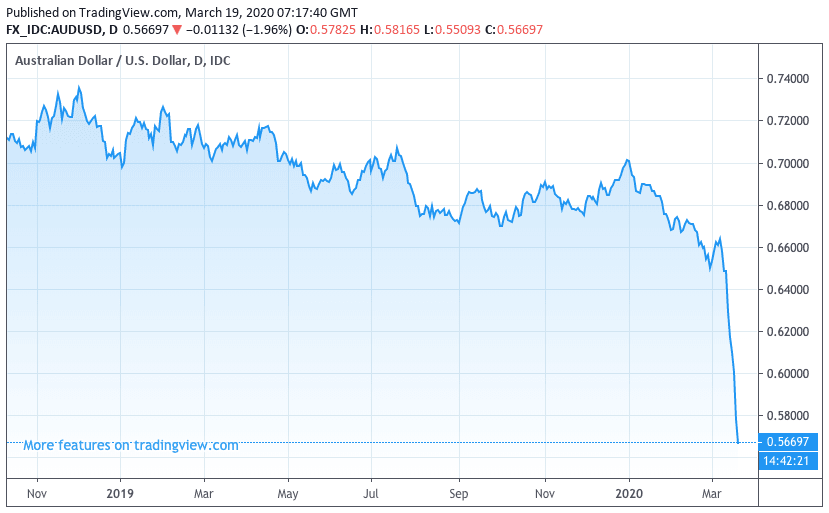Pound-Australian Dollar Exchange Rate Surges to 2.08 after RBA Throws Kitchen Sink at Coronavirus

Above: File image of RBA Governor Lowe, image © Crawford Forum, Reproduced Under CC Licensing
- GBP/AUD spot at time of writing: 2.0410
- Bank transfer rates (indicative): 1.9697-1.9839
- FX specialist transfer rates (indicative): 2.000-2.0227 >> More information
The Australian Dollar fell sharply in the wake of the decision by the Reserve Bank of Australia (RBA) to cut interest rates and commit to a sizeable quantitative easing programme to stave off the negative economic impacts of the global coronavirus outbreak.
The scale of the RBA's ambitions might have surprised some in the market, which could explain the ongoing decline in the value of the Australian Dollar following the decision.
The text-book currency reaction to a rate cut and introduction of quantitative easing is to go lower: however today's moves were well signposted to markets which have been engaged in a relentless selling of the Aussie currency for some days now. The FX market reaction to the actual announcement was always going to be pinned on the scale of any surprise around the scale of the moves.
The RBA cut the official cash rate (OCR) by 25bps to 0.25% and said "the Board will not increase the cash rate target until progress is being made towards full employment and it is confident that inflation will be sustainably within the 2–3 per cent target band".
Starting on March 20, the RBA will buy as many government bonds as is needed to ensure the yield on 3-year government bonds stays low and around 0.25%.
The programme is therefore open-ended, i.e. unlike some other central banks the RBA did not set a specific limit for its quantitative easing programme.
Other measures announced to help support the Australian economy include the establishment of a A$90BN term funding facility for commercial banks to help small and medium-sized businesses.
"This is similar to the initiative rolled out by the Bank of England last week. About 130 banks will reportedly be able to get onto the scheme," says Lee Sue Ann, Economist at UOB.
"The various elements of this package reinforce one another and will help to lower funding costs across the economy and support the provision of credit, especially to businesses," says Besa Deda, Chief Economist at St.George Bank. "This package is welcomed in trying to support the Australian financial system during extraordinary and challenging times. The virus has major health ramifications, as well as significant economic impacts."
The RBA's actions align it with other central banks that have introduced aggressive measures to help their respective economies and financial systems. Other developments over the past 24 hours saw the European Central Bank pledge €750bn of asset purchases of public and private securities. The U.S. Federal Reserve launched a programme to support money market mutual funds. The Bank of Japan promised an additional Y1.3trn of asset purchases.
Yet, markets continue to show significant signs of stress.
This should not be entirely unexpected, given that the crisis facing the world is ultimately a medical question that central bankers simply do not have the ultimate fix for.
"It’s unlikely that even in the short term the latest stimulus package will put an end to volatility in financial markets and uncertainty in the economy. A decline in the daily run rate of new global infections is needed first," says Deda.
But while central banks won't cure the coronavirus they can soften the blow of the impact of the disease while ensuring the financial system continues to function. The support to small businesses will be particularly welcome and there is a chance that the actions of central banks and governments might begin to ease market anxieties which can only be a good thing for the Aussie Dollar which tends to fall in times of market stresses.
Australian Dollar Under Significant Pressure
The moves at the RBA coincide with the Pound-to-Australian Dollar exchange rate jumping to 2.08, its highest level since 2015, as global market forces and investor sentiment remain the dominant driver in foreign exchange.
The Australian Dollar meanwhile continues to plummet against the U.S. Dollar, with AUD/USD quoting at 0.5672 on Thursday, down a further 2.17%. Taking its losses this March to 12%.
Losses in the Australian Dollar have come amidst a significant drop in the value of global stocks and commodities as investors prepare for a recession owing to the coronavirus outbreak.
"The instructions are that this is a Risk On Risk Off (RoRo) world and your positioning in that spectrum determines your performance. So the most Risk On currencies are currently NOK, AUD, GBP and NZD in that order," says David Bloom, Head of Global Foreign Exchange strategy at HSBC. "Now let's examine the FX movements over the last five days: NOK down 11.8%, AUD down 9.9%, GBP down 8.2% and NZD down 7.8%. In other words, the position of each currency is as RoRo would predict."
The market decline has meanwhile triggered a significant demand for cash, which is the natural consequence of selling investments. The U.S. Dollar has therefore naturally benefited as it forms the role of the world's reserve currency. Indeed, the demand for cash has created a liquidity crunch and therefore we are seeing a growing premium for U.S. Dollars.
Australian assets are being sold by foreign investors, which in turn adds to the global demand for U.S. Dollars while at the same time dropping the value of the Australian Dollar.
Until we see the sell-off ease, and a bottom appears to be in place, we would expect further declines in the currency.












